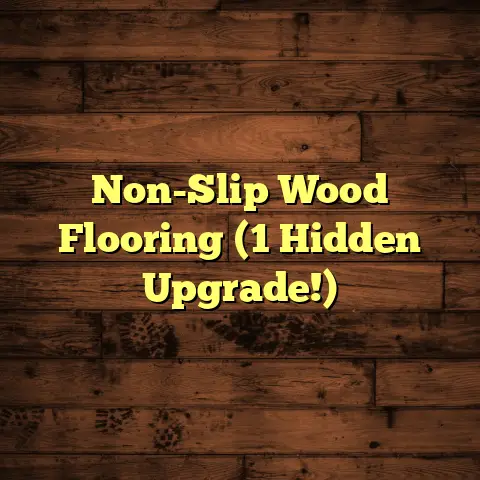Laminate & Pets: Easy Maintenance Tips? (3 Tricks!)
It’s budget-friendly, looks fantastic, and offers a durability that’s hard to beat. And for those of us who share our homes with furry, scaled, or feathered friends, laminate can be a lifesaver.
But here’s the thing: not all laminate is created equal, especially when pets are involved. One key factor that often gets overlooked is texture.
The right texture can make all the difference, not just in how your floor looks, but also in how well it holds up to the daily challenges of pet ownership.
Think about it: a smooth, glossy surface might look sleek, but it’s also a skating rink for your dog and a magnet for visible scratches.
Textured laminate, on the other hand, can offer better traction and camouflage minor imperfections.
In this article, I’m going to share three crucial tricks for maintaining laminate flooring when you have pets.
We’ll dive into the importance of texture, explore cleaning routines, discuss preventive measures, and tackle those inevitable pet accidents.
Let’s get started on making your laminate floors pet-proof and stylish!
Understanding Laminate Flooring Textures
Alright, let’s talk textures! When it comes to laminate flooring, the texture isn’t just about aesthetics; it’s about practicality, especially in a home with pets.
You’ve got a few main types to consider:
-
Hand-scraped: This texture mimics the look of real wood that’s been hand-scraped. It’s got a lot of variation and depth, which is fantastic for hiding pet hair, dirt, and those inevitable little scratches.
-
Embossed: Embossed laminate has a texture that aligns with the printed pattern. So, if it looks like wood grain, it feels like wood grain. This adds realism and can help with traction.
-
Embossed in Register (EIR): This is a more advanced type of embossing where the texture precisely matches the image. It’s super realistic and offers great slip resistance.
-
Smooth: Smooth laminate is, well, smooth! It’s easy to clean, but it shows everything. Think dust bunnies, paw prints, and scratches.
So, how do these textures impact your life with pets?
Textured laminate, particularly hand-scraped or EIR, is a game-changer. The uneven surface helps to mask pet hair and footprints.
I’ve had clients tell me they can go days without noticing pet hair on their hand-scraped laminate, whereas it would be glaringly obvious on a smooth surface within hours.
Let’s be real, who wants to spend all their free time cleaning?
Here’s a quick comparison:
| Feature | Textured Laminate (Hand-Scraped/EIR) | Smooth Laminate |
|---|---|---|
| Hides Pet Hair | Excellent | Poor |
| Hides Scratches | Good | Poor |
| Traction | Better | Worse |
| Cleaning Effort | Moderate | Easy |
| Overall Appearance Over Time | Holds up well | Shows wear |
Now, I’m not saying smooth laminate is a no-go. If you’re diligent about cleaning and your pets are relatively low-impact, it can work.
But, in my experience, textured laminate is the way to go for most pet owners. It offers a better balance of aesthetics, durability, and ease of maintenance.
Plus, that added texture can give your pets a little extra grip, which is especially important for older animals or those prone to slipping.
Think of it this way: you wouldn’t wear smooth-soled shoes on an icy sidewalk, right? Same principle applies to your furry friends and your floors.
Trick #1 – Regular Cleaning Routines
Okay, you’ve chosen your textured laminate – great! Now, let’s talk cleaning. I know, it’s not the most exciting topic, but trust me, a good cleaning routine is essential for keeping your floors looking their best.
The key here is consistency. A quick, regular cleaning is far more effective than waiting until your floors are covered in pet hair tumbleweeds and muddy paw prints.
Here’s what I recommend:
-
Daily Sweep or Vacuum: Use a soft-bristled broom or a vacuum cleaner with a hard floor attachment to remove loose dirt, dust, and pet hair. Pay special attention to high-traffic areas and corners where pet hair tends to accumulate.
-
Weekly Deep Clean: Once a week, give your floors a more thorough cleaning with a laminate-safe cleaner. I’m a big fan of using a microfiber mop – they’re super absorbent and won’t scratch your floors.
Pro Tip: Avoid steam mops! While they might seem like a quick and easy solution, the heat and moisture can damage laminate over time.
Choosing the Right Cleaning Products
This is crucial. You want to avoid anything too harsh or abrasive that could damage the finish of your laminate.
-
Laminate-Specific Cleaners: There are tons of laminate floor cleaners on the market. Look for pH-neutral formulas that are specifically designed for laminate.
-
DIY Solution: If you prefer a more natural approach, you can make your own cleaning solution with water and a small amount of white vinegar.
Step-by-Step Cleaning Guide
- Clear the Area: Remove any rugs, furniture, or obstacles from the area you’re cleaning.
- Sweep or Vacuum: Get rid of any loose dirt and debris.
- Prepare Your Cleaning Solution: Follow the instructions on your chosen cleaner, or mix your DIY solution.
- Mop the Floor: Dip your microfiber mop into the cleaning solution, wring it out thoroughly (you want it damp, not soaking wet), and mop the floor in overlapping strokes.
- Dry the Floor: If necessary, dry the floor with a clean, dry microfiber cloth.
Dealing with Pet Hair
Pet hair can be a real pain, especially if you have a shedding breed. Here are a few extra tips for tackling pet hair:
-
Use a Rubber Broom: Rubber brooms are fantastic for attracting pet hair. The rubber bristles create static electricity that helps to pull hair off the floor.
-
Pet Hair Vacuum Attachment: If you have a vacuum cleaner, invest in a pet hair attachment. These attachments are designed to lift pet hair from surfaces more effectively than standard attachments.
-
Lint Roller: For small areas or quick touch-ups, a lint roller can be a lifesaver.
Frequency of Cleaning
How often you need to clean depends on a few factors:
- Number of Pets: More pets = more cleaning.
- Breed of Pets: Some breeds shed more than others.
- Activity Level: Active pets track in more dirt.
- Season: Pets tend to shed more during seasonal changes.
As a general rule, I recommend daily sweeping or vacuuming and a weekly deep clean. But, you might need to adjust this based on your specific circumstances.
Remember: Consistency is key! A little bit of effort on a regular basis will go a long way in keeping your laminate floors looking their best.
Trick #2 – Preventive Measures for Scratches and Damage
Alright, now that we’ve covered cleaning, let’s talk about prevention. Because, let’s face it, the best way to deal with scratches and damage is to prevent them from happening in the first place.
Here are some of my top tips for protecting your laminate floors from your furry friends:
1. Area Rugs and Mats: Your First Line of Defense
Area rugs and mats are your best friends when it comes to protecting your laminate floors. Place them in high-traffic areas, such as:
- Entryways: To catch dirt and debris before it gets tracked onto your floors.
- Under Pet Bowls: To protect against spills and splashes.
- In Front of Couches and Chairs: Where your pets like to hang out.
- Play Areas: Where your pets are most active.
Pro Tip: Choose rugs with a non-slip backing to prevent them from sliding around and potentially scratching your floors.
2. Nail Care: A Must for Pet Owners
Keeping your pets’ nails trimmed is crucial for protecting your laminate floors. Long nails can scratch and damage the surface, especially when your pets are running, playing, or just walking around.
- Regular Trimming: Trim your pets’ nails every 2-4 weeks, depending on how quickly they grow.
- Professional Grooming: If you’re not comfortable trimming your pets’ nails yourself, take them to a professional groomer.
- Scratching Posts/Pads: Provide your cats with plenty of scratching posts or pads to encourage them to scratch in appropriate places.
3. Training: Teaching Good Habits
Training your pets to stay off certain areas of the house or to avoid certain behaviors can also help to protect your laminate floors.
- “Off” Command: Teach your dogs the “off” command to keep them from jumping on furniture or running through the house.
- Designated Play Areas: Create designated play areas for your pets, where they can run and play without damaging your floors.
- Positive Reinforcement: Use positive reinforcement techniques, such as treats and praise, to encourage good behavior.
4. Furniture Pads: Protecting Against Scratches
Furniture pads are small felt or rubber pads that you can attach to the bottom of your furniture legs. They help to prevent scratches and dents when you move furniture around.
- Apply to All Furniture: Apply furniture pads to the legs of all your furniture, including chairs, tables, sofas, and beds.
- Replace Regularly: Replace furniture pads regularly, as they can wear out over time.
5. Choose the Right Toys
Some pet toys can be rough on laminate floors. Avoid toys that are hard, sharp, or have rough edges.
- Soft Toys: Opt for soft toys that are less likely to scratch or damage your floors.
- Avoid Hard Chews: Avoid giving your dogs hard chew toys that they can drag across the floor.
6. Be Mindful of Water
Water can damage laminate floors if it’s left to sit for too long. Be sure to clean up any spills or accidents immediately.
- Water Bowls: Use mats under water bowls to catch spills.
- Dry Paws: Dry your pets’ paws after they come in from outside, especially on rainy or snowy days.
Remember: Prevention is always better than cure. By taking these simple steps, you can significantly reduce the risk of scratches and damage to your laminate floors.
Trick #3 – Dealing with Accidents
Okay, let’s face it, accidents happen. No matter how well-trained your pets are, there will be times when they have an accident on your laminate floor.
The key is to act quickly and clean it up properly to prevent staining, odors, and damage to your flooring.
1. Act Fast: Time is of the Essence
The sooner you clean up an accident, the less likely it is to cause permanent damage.
- Blot, Don’t Rub: Use a clean cloth or paper towel to blot up as much of the liquid as possible. Avoid rubbing, as this can spread the mess and push it deeper into the floor.
- Remove Solids: If there are any solid pieces, carefully remove them with a spatula or scraper.
2. Choose the Right Cleaning Products
Again, you want to use cleaning products that are safe for both your laminate floors and your pets.
- Enzyme Cleaners: Enzyme cleaners are specifically designed to break down pet stains and odors. They’re a great choice for dealing with urine, feces, and vomit.
- Laminate-Safe Cleaners: As mentioned before, use a laminate-safe cleaner to clean the affected area.
- DIY Solution: A solution of water and white vinegar can also be effective for cleaning up pet accidents.
Pro Tip: Always test any cleaning product in an inconspicuous area first to make sure it doesn’t damage your flooring.
3. Step-by-Step Cleaning Guide
- Blot Up the Mess: As mentioned above, blot up as much of the liquid as possible.
- Apply Cleaning Solution: Apply your chosen cleaning solution to the affected area.
- Let it Sit: Let the cleaning solution sit for a few minutes to allow it to break down the stain and odor.
- Wipe Clean: Wipe the area clean with a damp cloth.
- Dry the Floor: Dry the floor with a clean, dry cloth.
4. Dealing with Lingering Odors
Sometimes, despite your best efforts, odors can linger after cleaning up a pet accident. Here are a few tips for getting rid of those stubborn odors:
- Baking Soda: Sprinkle baking soda over the affected area and let it sit overnight. Vacuum it up the next day.
- Activated Charcoal: Place a bowl of activated charcoal near the affected area to absorb odors.
- Air Fresheners: Use pet-friendly air fresheners to help neutralize odors.
5. Preventing Future Accidents
While you can’t always prevent accidents from happening, there are a few things you can do to reduce the likelihood of future occurrences:
- Potty Training: Make sure your pets are properly potty trained.
- Regular Potty Breaks: Take your pets outside for regular potty breaks.
- Clean Litter Boxes: Keep your cats’ litter boxes clean and fresh.
- Address Medical Issues: If your pets are having frequent accidents, consult with your veterinarian to rule out any underlying medical issues.
6. When to Call a Professional
In some cases, pet accidents can cause permanent damage to your laminate flooring. If you’ve tried everything and you’re still unable to remove the stain or odor, it may be time to call a professional flooring cleaner.
Remember: Accidents happen, but with the right cleaning techniques and products, you can minimize the damage and keep your laminate floors looking their best.
Conclusion
So, there you have it – my top three tricks for maintaining laminate flooring when you have pets.
We’ve talked about the importance of texture, the need for regular cleaning routines, and the importance of preventive measures.
We’ve also covered how to deal with those inevitable pet accidents.
The right texture can make a huge difference in how well your laminate flooring holds up to the wear and tear of pet ownership.
Regular cleaning routines are essential for keeping your floors looking their best and preventing the buildup of dirt, hair, and odors.
And preventive measures can help to minimize the risk of scratches and damage.
I hope these tips have been helpful and that you’re feeling more confident about keeping your laminate floors looking great, even with pets.
With the right approach, you can create a harmonious living space that accommodates both your pets and your home aesthetics.
Call to Action
Now, I’d love to hear from you! What are your experiences with laminate flooring and pets? Do you have any other tips or tricks to share? Let’s start a conversation in the comments below!





